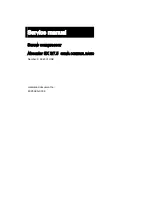
16
3. Keep fingers off trigger of tool until ready to use.
A tool has power when compressor has air.
4. Ensure connections are tight/secure. Firmly grasp
hose in hand when connecting or disconnecting
to prevent hose whip. An improperly seated
coupler can blow off the machine when started.
WARNING: High pressure stream hazard
Never direct air stream at people or animals. A high-
pressure stream produced by this compressor could
pierce the skin and underlying tissues, leading to a
serious injury or amputation. DO NOT TREAT AN
INJECTION INJURY AS A SIMPLE CUT! In case of
skin injection, see a physician immediately.
Note: To change tools or attachments, change out the
tools on the end of the hose. There is a check valve
built into the hose coupler so that air does not escape
when tools are removed.
WARNING: Projectile hazard
Never disconnect threaded joints with pressure in the
tank. Removing threaded connections with pressure in
the tank may cause the removed component to become
a projectile.
Do not string hoses across floors or aisles where
they are liable to cause personnel to trip and fall.
Suspend air supply hoses overhead, or otherwise
locate to provide sufficient access and protection
against damage.
Using Compressor for Spraying
Spraying flammable materials.
Always follow
precautions on container labels or MSDS’ before
spraying flammable materials such as paint.
Moisture in Compressed Air
Moisture in compressed air will form into droplets as it
leaves air compressor pump. When humidity is high or
when a compressor is in continuous use for an extended
period of time, this moisture will collect in the tank.
When using a paint spray or sandblast gun, this water
will be carried from the tank through the hose, and out of
the gun as droplets mixed with the spray material. If this
is not acceptable for your application, an external air
dryer must be added to the system.
Shutdown Procedures
Normal Shutdown
1. Move the pressure switch lever to OFF and turn
regulator knob counter-clockwise to stop/shut off
air-flow.
2. Turn engine switch to OFF position.
3. Turn fuel valve lever to OFF position.
4. Drain air from the tank by releasing pressure.
Disconnect hoses and open drain valve or pull the
ring on the safety relief valve.
Note: Lifting the unloader knob will not release
pressure from the tank.
5. Once the air tank pressure gauge registers under
10 PSI, open the drain valve on the bottom of the
tank to drain any moisture.
6. Remove spark plug to prevent accidental starting
of engine.
7. Cool engine at least 5 minutes before storing. A
hot engine is a fire hazard. (See “
Storage
” section
for more information.)
Malfunction during operation.
Immediately turn off the compressor if any of the
following conditions arise during operation:
Excessive change in engine speed, slow or fast
Overheating
Excessive vibration
Unusual noise
Flame or smoke
Air leakage
To stop the compressor in an emergency:
1. Move the pressure switch lever to OFF and close
the ball valve to stop/shut off air-flow
2. Turn engine switch to OFF position.
3. Turn fuel valve lever to OFF position.
4. Pull the safety relief valve to quickly release
pressure from the tank.
5. Remove spark plug to prevent accidental starting
of engine.
6. Ensure compressor will not be re-started until
problem is remedied.
WARNING: Shutdown hazards
Do not leave an operating machine unattended. Always
shut the machine OFF and relieve the pressure before
leaving the machine. NEVER disconnect the high-
pressure hose from the unit while the tank and air line is
pressurized.













































